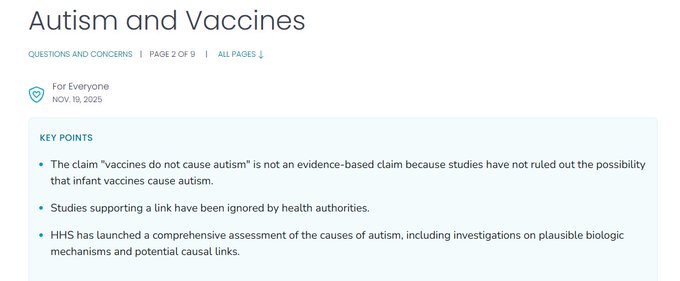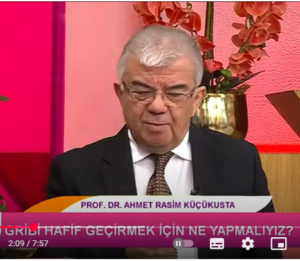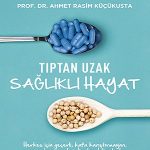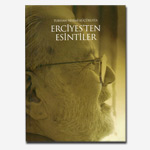AŞILAR OTİZME SEBEP OLMAZ İDDİASI KANITA DAYALI DEĞİLDİR
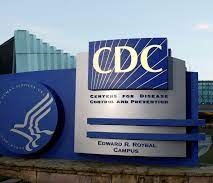
💥💥💥Bilim dünyasına nükleer bomba düştü!
Şu tüm filim adamlarının taptığı, her sözünü emir telâkki ettiği CDC bakın ne diyor:
▶“Aşılar otizme sebep olmaz” iddiası kanıta dayalı bir iddia değildir, çünkü çalışmalar bebek aşılarının otizme sebep olma ihtimalini ortadan kaldırmamıştır.
▶Otizmle aşılar arasında bağlantı olduğunu destekleyen çalışmalar sağlık otoriteleri tarafından görmezden gelinmiştir.
▶ABD Sağlık ve İnsan Hizmetleri Bakanlığı, otizmin sebepleri üzerine kapsamlı bir değerlendirme başlatmıştır; bu değerlendirme makul biyolojik mekanizmaları ve muhtemel illiyet bağlantılarını da kapsıyor.
Dün yani 19 kasımda güncellenmiş.
Gelelim neticeye
CDC’ nin bugün söylediklerini senelerdir söylüyorum.
Bu sebeple hakkımda halk sağlığına zarar verdiğim iddiasıyla soruşturmalar açıldı, cezalar verildi ama tabii ki tümü de mahkemelerden döndü.
Hakikatlerin bir gün ortaya çıkmak gibi çok mühim hususiyetleri vardır.
***
CDC’ nin sayfasından iktibastır:
Vaccines do not cause Autism*
Pursuant to the Data Quality Act (DQA), which requires federal agencies to ensure the quality, objectivity, utility, and integrity of information they disseminate to the public, this webpage has been updated because the statement “Vaccines do not cause autism” is not an evidence-based claim. Scientific studies have not ruled out the possibility that infant vaccines contribute to the development of autism. However, this statement has historically been disseminated by the CDC and other federal health agencies within HHS to prevent vaccine hesitancy.
HHS has launched a comprehensive assessment of the causes of autism, including investigations on plausible biologic mechanisms and potential causal links. This webpage will be updated with gold-standard science that results from the HHS comprehensive assessment of the causes of autism as required by the DQA.
The following, as required by the DQA, details the state of the evidence and studies, and the lack thereof, regarding vaccines and autism spectrum disorder (autism) and outlines HHS future research directions to provide answers.
Background
It is critical to address questions the American people have about the cause of autism to ensure public health guidance is adequately responsive to their concerns. Approximately one in two surveyed parents of autistic children believe vaccines played a role in their child’s autism, often pointing to the vaccines their child received in the first six months of life (Diphtheria, tetanus, pertussis (DTaP), Hepatitis B (HepB), Haemophilus influenzae type B (Hib), Poliovirus, inactivated (IPV), and Pneumococcal conjugate (PCV)) and one given at or after the first year of life (Measles, mumps, rubella (MMR)). This connection has not been properly and thoroughly studied by the scientific community.
In 1986, the CDC’s childhood immunization schedule for infants (≤ 1 year of age) recommended five total doses of vaccines: two oral doses of oral polio vaccine (OPV) and three injected doses of Diphtheria and Tetanus Toxoids and Pertussis Vaccine (DTP). In 2025, the CDC schedule recommended three oral doses of Rotavirus (RV) and three injected doses each of HepB, DTaP, Hib, PCV, and IPV by six months of age, two injected doses of Influenza (IIV) by 7 months of age, and injected doses of Hib, PCV, MMR, Varicella (VAR), and Hepatitis A (HepA) at 12 months of age.
The rise in autism prevalence since the 1980s correlates with the rise in the number of vaccines given to infants. Though the cause of autism is likely to be multi-factorial, the scientific foundation to rule out one potential contributor entirely has not been established. For example, one study found that aluminum adjuvants in vaccines had the highest statistical correlation with the rise in autism prevalence among numerous suspected environmental causes. Correlation does not prove causation, but it does merit further study.
The National Childhood Vaccine Injury Act of 1986 required that “the Secretary of Health and Human Services shall complete a review of all relevant medical and scientific information … on the nature, circumstances, and extent of the relationship, if any, between vaccines containing pertussis … and the following illnesses and conditions.” The statute lists 11 specific illnesses and conditions, including autism.
Since then, multiple reports from HHS and the National Academy of Sciences’ Institute of Medicine have examined the links between autism and vaccines. These reviews have consistently concluded that there are still no studies that support the specific claim that the infant vaccines, DTaP, HepB, Hib, IPV, and PCV, do not cause autism and hence the CDC was in violation of the DQA when it claimed, “vaccines do not cause autism.” CDC is now correcting the statement, and HHS is providing appropriate funding and support for studies related to infant vaccines and autism.
Below is a brief timeline and summary of the key findings related to the 1986 directive from Congress regarding the pertussis vaccine and autism.
1991 – Institute of Medicine
Key Finding: “No data were identified that address the question of a relation between vaccination with DPT or its pertussis component and autism. There are no experimental data bearing on a possible biologic mechanism.” 1
2012 – Institute of Medicine
Key Finding: “The evidence is inadequate to accept or reject a causal relationship between diphtheria toxoid–, tetanus toxoid–, or acellular pertussis–containing vaccine and autism.” 2
• Note: The only study the IOM located regarding DTaP and autism found an association, but the IOM discounted it because it provided data from CDC’s passive surveillance system (HHS VAERS) and lacked an unvaccinated comparison population.
2014 – HHS Agency for Healthcare Research and Quality
Key Finding: A comprehensive review of the studies investigating the safety of routine childhood vaccines concluded that there was no evidence to accept or reject a causal relationship between DTaP and autism. 3
2021 – HHS Agency for Healthcare Research and Quality
Key Finding: The findings from the 2012 IOM report and the 2014 AHRQ report (based on the IOM) of insufficient evidence for an association between autism and DTaP/Tdap/Td remained unchanged. The 2021 update identified no new studies; the scientific evidence continued to be insufficient to support or reject a causal relationship between those vaccines and autism. 4
- National Academies of Sciences, Engineering, and Medicine. 1991. Adverse Effects of Pertussis and Rubella Vaccines. Washington, DC: The National Academies Press. https://doi.org/10.17226/1815. P. 151-152.
- National Academies of Sciences, Engineering, and Medicine. 2012. Adverse Effects of Vaccines: Evidence and Causality. Washington, DC: The National Academies Press. https://doi.org/10.17226/13164. P. 545-546
- Maglione, M. A., Gidengil, C., Das, L., Raaen, L., Smith, A., Chari, R., Newberry, S., Hempel, S., Shanman, R., Perry, T., & Goetz, M. B. (2014). Safety of Vaccines Used for Routine Immunization in the United States. Evidence report/technology assessment, (215), 1–740. https://doi.org/10.23970/AHRQEPCERTA215. P. 133
- Gidengil, C., Goetz, M. B., Maglione, M., Newberry, S. J., Chen, P., O’Hollaren, K., Qureshi, N., Scholl, K., Ruelaz Maher, A., Akinniranye, O., Kim, T. M., Jimoh, O., Xenakis, L., Kong, W., Xu, Z., Hall, O., Larkin, J., Motala, A., & Hempel, S. (2021). Safety of Vaccines Used for Routine Immunization in the United States: An Update. Agency for Healthcare Research and Quality (US). https://doi.org/10.23970/AHRQEPCCER244. P. 85-87; 103-104
Of note, the 2014 AHRQ review also addressed the HepB vaccine and autism. One cross-sectional study met criteria for reliability; it found a threefold risk of parental report of autism among newborns receiving a HepB vaccine in the first month of life compared to those who did not receive this vaccine or did so after the first month. After reviewing the study, AHRQ determined that there was insufficient evidence of an association of the HepB vaccine and autism.
In fact, there are still no studies that support the claim that any of the 20 doses of the seven infant vaccines recommended for American children before the first year of life do not cause autism. These vaccines include DTaP, HepB, Hib, IPV, PCV, rotavirus, and influenza.
State of the Evidence: MMR Vaccine
MMR VaccineThe MMR vaccine has been studied regarding autism, and the reviews from IOM and AHRQ maintain with a high strength of evidence that there is no association with autism spectrum disorders based on observational evidence only.
However, in 2012, the IOM reviewed the published MMR-autism studies and found that all but four of them had “serious methodological limitations,” and the IOM gave them no weight. The remaining four studies and a few similar studies published since also have all been criticized for serious methodological flaws. Furthermore, they are all retrospective epidemiological studies which cannot prove causation, fail to account for potential vulnerable subgroups, and fail to account for mechanistic and other evidence linking vaccines with autism.
Many of the retrospective studies utilized, such as the 2002 New England Journal of Medicine study on the Denmark population, may be unreliable for the U.S. population. Children in these studies receive vaccines based on foreign vaccination schedules that differ from the schedule in the U.S. As outlined in the 2013 IOM report on the childhood immunization schedule, “there are few comparative studies evaluating the safety of different vaccine schedules,” but “there are cases in which the risk of adverse events can depend on the vaccination schedule used and factors such as timing and adjuvants should be studied with appropriate design methods.”
For example, the MMR vaccine does not contain aluminum. However, other infant vaccines have aluminum content ranging from 0.25 mg to 0.625 mg per dose (DTaP has the highest content). One analysis found that the 2019 CDC vaccine schedule resulted in 4.925 mg of total vaccine-related aluminum exposure by age 18 months. There is evidence in the U.S. of a positive association between vaccine-related aluminum exposure and persistent asthma. Evidence from a large Danish cohort study reported no increased risk for neurodevelopmental disorders with early childhood exposure to aluminum-adsorbed vaccines, but a detailed review of the supplementary tables shows some higher event rates of neurodevelopmental conditions with moderate aluminum exposure (Supplement Figure 11 — though a dose response was not evident) and a statistically significant 67% increased risk of Asperger’s syndrome per 1 mg increase in aluminum exposure among children born between 2007 and 2018 (Supplement Figure 4). Together, these findings warrant further investigation of aluminum exposures (high, low, and none) for a variety of childhood chronic diseases, including autism.
HHS Research on Plausible Biologic Mechanisms between Vaccines and Autism
HHS will evaluate plausible biologic mechanisms between early childhood vaccinations and autism. Mechanisms for further investigation include the impacts of aluminum adjuvants, risks for certain children with mitochondrial disorders, harms of neuroinflammation, and more.
* The header “Vaccines do not cause autism” has not been removed due to an agreement with the chair of the U.S. Senate Health, Education, Labor, and Pensions Committee that it would remain on the CDC website.
https://www.cdc.gov/vaccine-safety/about/autism.html
Kaynak: https://x.com/drahmetrasim/status/1991383576894468153?s=20
***








